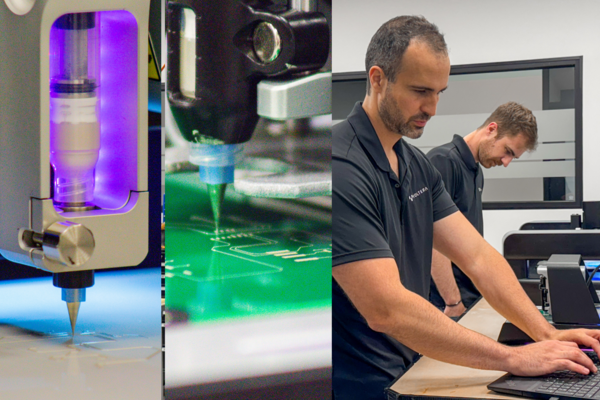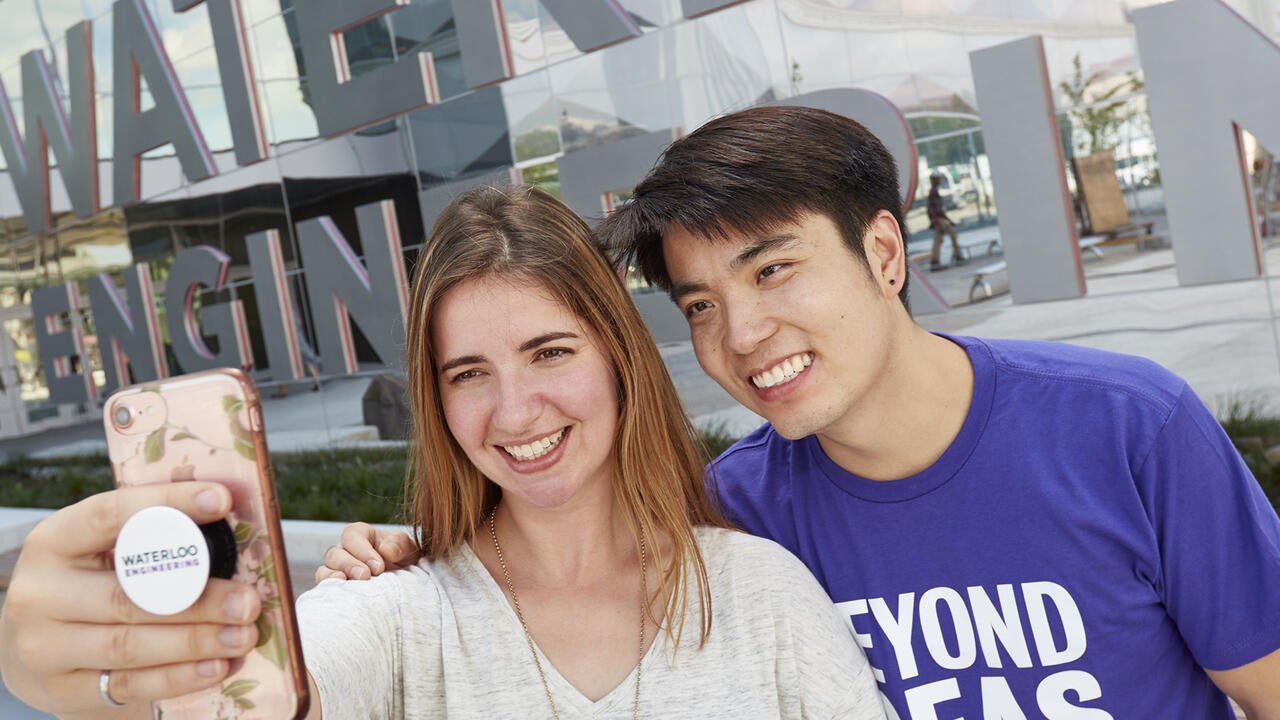Students walking into Engineering 7 this term are entering a building like no other. Since the first shovel went in the ground in November 2015, excitement has grown for our seven-storey, 242,000-square-foot building, which officially opens its doors on October 29. With its extraordinary facilities, we are ensuring our continued educational leadership while equipping students to tackle the truly difficult problems facing our society.
Here’s a sneak peek at seven of the many ways Engineering 7 provides a dynamic gateway to educating the engineer of the future.
1. Enhanced educational experience
Student experience is also enriched with a state-of-the-art student workshop, a machine shop and an electronic components shop. New student garages provide a dedicated spot for fourth-year teams to collaborate and build their Capstone Design projects.
The flagship teaching space is the two-storey Engineering Ideas Clinic®. Equipped with built-in water zones, sandpits and much more, the clinic provides all undergraduate engineering students with exposure to hands-on problem solving and realistic testing of projects.
Activities organized by the Engineering Ideas Clinic® range from in-class projects such as taking apart internal combustion engines to open-ended problems requiring students to work in teams and draw on all of their academic lessons to find solutions.
“We’re connecting the digital and physical worlds, using the deep engineering knowledge for which our curriculum is known,” says Sanjeev Bedi, a mechanical and mechatronics engineering professor and the Natural Sciences and Engineering Research Council Chair in Immersive Design Engineering Activities (IDEAs). “Our students see the relevance of each course as their skills grow and it feeds into what we at Waterloo pride ourselves on — innovation and entrepreneurship.”
2. Expanded home for six engineering programs
Welcome to much more — and much-needed — room for electrical engineering, computer engineering, mechanical engineering, mechatronics engineering, biomedical engineering and systems design engineering. With dedicated incubation space for each program, we are helping to ensure both the economic and innovation future of Canada.
Engineering 7 is allowing us to meet the demands of enrolment growth — both our mechatronics and biomedical engineering programs are rapidly expanding, and we are increasing our undergraduate enrolment overall by an additional 1,500 students.
“I’m excited about the student space in Engineering 7,” says Natisa Jeyakanthan, a fourth-year biomedical engineering student. “Specifically, the study and social areas and the lecture halls will be useful as the biomedical engineering program continues to grow.”
3. More exceptional research space
From world-class additive manufacturing facilities to the one-of-a-kind RoboHub, we are strengthening our research capacities in emerging and disruptive technologies.
The third-floor Multi-Scale Additive Manufacturing Lab is one of Canada’s largest 3D-printing facilities. From new design systems to multi-material processes, this lab will help ensure our nation’s technological competitiveness in new design systems, multi-material processes and much more.
The RoboHub is the only experimental facility in the world with aerial, mobile, humanoid and levitated robots under one roof, opening new avenues of multidisciplinary research that combines the potential of these different robotic technologies.
The space has an advanced indoor motion-tracking system and movable features such as fans, stairs and doors, along with a unique fleet of autonomous robots and manipulator arms. A dedicated control centre attached to the RoboHub enables high-level coordination of robot motions as well as advanced 3D visualization.
“Nowhere else on the planet do you find the same advanced robotics technology under one roof,” says William Melek, director of mechatronics engineering. “It places Canada at the forefront of this strategically important emerging field.”
4. Permanent home for Outreach
Housed in a portable for seven years, Waterloo Engineering’s Outreach is now located on Engineering 7’s first floor, providing easy access to the headquarters of Engineering Science Quest and other acclaimed camps, high school leadership programs and Women in Engineering initiatives.
The new location not only provides a much larger, multi- functional space for Outreach, it also serves as a professional front door to its programming.
“When we book a meeting with someone, we no longer need to tell them to come to a portable,” says Martin Scherer, manager of Outreach. “Having dedicated delivery space also means we can offer more programming year-round.”
An added bonus?
“Staff won’t need a jacket in the winter to go to the bathroom,” Scherer says with a laugh.
5. New headquarters for the Conrad School of Entrepreneurship and Business
There is a new name as well as a new location for the Conrad School of Entrepreneurship and Business. Officially designated as a school this past spring, it was renamed from the Conrad Business, Entrepreneurship and Technology Centre.
For years, a visit to Conrad has meant a trip across campus and Columbia Street to the second floor of the Accelerator Centre. Now it’s a quick elevator ride — or a set of stairs — to the school, which is located on the second floor in Engineering 7.
The centrally located space provides Master of Business, Entrepreneurship and Technology (MBET) students with entrepreneurship training and direct access to business mentors. It’s also the main-campus home for our undergraduate entrepreneurship option launched in 2015.
Conrad’s move from North Campus to the heart of Engineering 7 and the physical heart of the Faculty of Engineering promises to profoundly enhance our students’ experience at Waterloo and to leverage Conrad’s potential impact on Engineering and the larger University,” says Mark Weber, director of Conrad. “Exciting things are going to happen here.”
6. Additional room to accommodate graduate student growth
Waterloo Engineering’s enrolment growth continues beyond undergraduates to the graduate student level. Now with Engineering 7’s cutting-edge facilities, we will attract more top students from Canada and around the world to our graduate programs, where they can develop and test their ideas and undertake discovery in emerging and disruptive technologies.
Fiona Khor, a mechanical engineering master’s candidate, welcomes the additional space for graduate students. “There has been a shortage of graduate student offices and labs with the increase in incoming graduate students.” says Khor, whose research is in the area of injury biomechanics. “The additional graduate offices and facilities in Engineering 7 now allow students to work in a comfortable office environment in close proximity to their peers and supervisors.”
7. Opening of a new C&D!
Much to the delight of students, faculty members, staff and others needing a java fix, Waterloo Engineering’s second C&D (short for coffee and doughnuts) is conveniently located on the first floor. Much like the original C&D in Carl Pollock Hall (CPH), this one, also operated by the Engineering Society, is already a regular early-morning, mid-day and late-afternoon stop for many. Along with the numerous blends of coffee and different types of sweet treats, it carries everything from soup to nuts — with lots in between.
Related stories

Read more
Made by Waterloo: Prototyping the future of innovation
Voltera prints electronics making prototyping faster and more affordable — accelerating research to market-ready solutions

Read more
Made by Waterloo
Discover how Waterloo alumni are driving Canada’s economy with five tech companies making a local and global impact

Read more
Building a generation of student entrepreneurs
Velocity’s partnership with local hospitals and organizations helps streamline the ideation process for students invested in creating the next big health-tech solution





